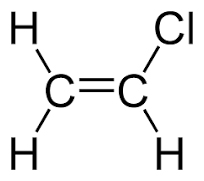Toxaphene
What is Toxaphene? Toxaphene is a mixture of hundreds of different chlorinated compounds. It was one of the most heavily used pesticides in the Unites States until 1982, when it was canceled for most uses. All registered uses were banned by 1990. In its original form, toxaphene is a yellow to amber waxy solid that has a piney odor.Read More
Trichlorobenzene
What is Trichlorobenzene? Trichlorobenzene appears as colorless liquid or white solid with a sharp chlorobenzene odor. Trichlorobenzene is used as a dye carrier, an herbicide intermediate, a heat-transfer medium, a dielectric fluid in transformers, a degreaser, a lubricant, in synthetic transformer oils, and as a solvent in chemical manufacturing. Trichlorobenzene was formerly used as an insecticide against termites.Read More
Trichloroethylene (TCE)
 What is Trichloroethylene (TCE)?
What is Trichloroethylene (TCE)?
Trichloroethylene is a halocarbon commonly used as an industrial solvent. It is a clear, non-flammable liquid with a sweet smell. Trichloroethylene is the first daughter product produced when breaking down tetrachloroethylene, also known as perchloroethylene (PCE).
Uses
It is primarily used as a dry-cleaning solvent, as well as to make refrigerants and degreasing solvents for metal equipment. TCE is also used in some household products, such as cleaning wipes, aerosol cleaning products, tool cleaners, paint removers, spray adhesives, and carpet cleaners.
Sources & Potential Exposure
TCE can enter ground and surface water from industrial discharges or from improper disposal of cleaning chemicals. Most TCE in the air comes from metal degreasing activities associated with tool and automobile production. Trichloroethylene is a mild to severe skin, eye, and respiratory-tract irritant. Acute exposure can cause CNS and respiratory depression and cardiac dysrhythmias by inhalation or ingestion.
Federal Regulations
The International Agency for Research on Cancer (IARC) classified trichloroethylene as carcinogenic to humans. The EPA and FDA have set a maximum limit (5 ppb or 5 ug/L) for TCE in drinking water.
REGENESIS Treatment Products – Trichloroethylene
• PlumeStop
• RegenOx
• PersulfOx
• 3DME
• Aquifix
• BDI Plus
• CRS
• S-MicroZVI
Trichlorofluoroethane (Freon 113)
What is Trichlorofluoroethane (Freon 113)? Trichlorofluoroethane appears as a clear light colored liquid. Nearly odorless. Denser than water. Uses: cooling agent, cleansing agent for metal and electrical components, aerosol propellant, blowing agent for foam production, solventRead More
Trichlorofluoromethane (Freon 11)
What is Trichlorofluoromethane (Freon 11)? Trichlorofluoromethane appears as a clear light colored liquid. Nearly odorless. Denser than water. It is a halomethane and a chlorofluorocarbon.Read More
Trichloropropane
What is 1,2,3-Trichloropropane? 1,2,3-Trichloropropane is a synthetic chemical that is also known as allyl trichloride, glycerol trichlorohydrin, and trichlorohydrin. It is a colorless, heavy liquid with a sweet but strong odor. It evaporates very quickly and small amounts dissolve in water.Read More
Trimethylbenzene
What is Trimethylbenzene? Trimethylbenzene appears as a liquid. Flash point near 130°F. Less dense than water and insoluble in water. Trimethylbenzene has been used in fuels and fuel additives, intermediates, paint additives and coating additives, solvents for cleaning and degreasing, and solvents which become part of product formulation or mixture.Read More
Vinyl Chloride (VC)
Vinyl Chloride (VC)
What is VC?
Vinyl Chloride is an organochloride with the formula H2C=CHCl that is also called vinyl chloride monomer (VCM) or chloroethene. This colorless compound is an important industrial chemical chiefly used to produce the polymer polyvinyl chloride (PVC). About 13 billion kilograms are produced annually.
Uses
Most of the vinyl chloride produced in the United States is used to make polyvinyl chloride (PVC), a material used to manufacture a variety of plastic and vinyl products including pipes, wire and cable coatings, and packaging materials. Smaller amounts of vinyl chloride are used in furniture and automobile upholstery, wall coverings, housewares, and automotive parts. Vinyl chloride has been used in the past as a refrigerant.
Sources & Potential Exposure
Most vinyl chloride is used to make polyvinyl chloride (PVC) plastic and vinyl products. Acute (short-term) exposure to high levels of vinyl chloride in air has resulted in central nervous system effects (CNS), such as dizziness, drowsiness, and headaches in humans. Chronic (long-term) exposure to vinyl chloride through inhalation and oral exposure in humans has resulted in liver damage. Cancer is a major concern from exposure to vinyl chloride via inhalation, as vinyl chloride exposure has been shown to increase the risk of a rare form of liver cancer in humans.Vinyl chloride is a microbial degradation product of trichloroethylene in groundwater, and thus can be found in groundwater affected by trichloroethylene contamination.
Federal Regulations
EPA has classified vinyl chloride as a Group A, human carcinogen.

 Americas
Americas Europe
Europe Français
Français Deutsch
Deutsch Italiano
Italiano Español
Español




